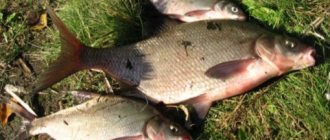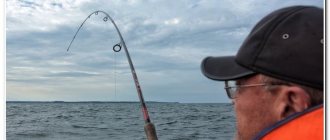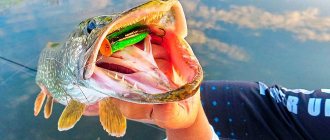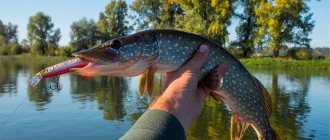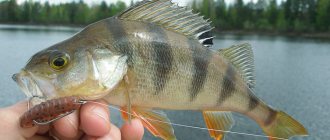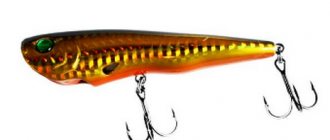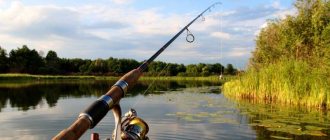Pike in September
Pike fishing in September depends on the vagaries of the weather of that month. The range of night and day temperatures can be more than 15 degrees. Sunny days can quickly give way to cloudy and rainy days, and sudden changes in weather conditions can occur within 24 hours. In such conditions, pike fishing becomes more difficult. But the voracious predator constantly needs food, and if you know the peculiarities of its behavior at the beginning of autumn, you can count on productive fishing.
On sunny days, pike ambush in shaded coastal areas in September. Tree crowns hanging over the water, abundant coastal vegetation, the presence of trees fallen into the water, snags and scurrying schools of small fish are excellent signs of the presence of pike. In bays, small rivers and small lakes, a hidden predator can be seen from the shore without special equipment. She also gives herself away with sharp lunges for her prey.
In the first half of September, pike can be successfully caught with all available gear, using artificial baits and live bait. On sunny, warm days, pike rarely leave their shelters. Moreover, potential prey itself often swims up to the predator “under the nose.” In such conditions, fishing of the coastal strip is carried out. When fishing with a spinning rod, it is more convenient to fish from a boat, wade or from bridges. Live bait gear is also cast in the coastal zone.
As the temperature steadily decreases, and when the thermometer does not reach 20°, pike more often leaves the coastal zone, and can be found in any part of the reservoir in which small fish are concentrated.
It should be taken into account that crucian carp, perch or roach weighing about 100 g are potential prey for predators.
In mid-autumn, on large lakes, the probability of catching pike increases when fishing by trolling and with mugs.
Seasonal features of pike fishing in autumn
Since predator behavior varies from month to month, success will require knowledge of the intricacies of each.
September
If the month turns out to be warm, then you should not expect a bite from a predator. Pike begin to bite in the fall towards the end of September, when it gets cooler. Since the food base does not move far from the usual sites, it is worth fishing in areas near the edges, places with a weak current. The catch can also be expected on the return rivers, coastal “lulls” with a slow current. It is not recommended to ignore snags, oxbow lakes, channels with shallow depths and slow water flow. Pike often lives near areas with uneven bottom relief on dumps and slopes.
October
This month, the predator’s bite is characterized as stable, its behavior is active, and it reacts to all offered bait. Calm occurs when there are sudden changes in atmospheric pressure. Considering that pike move away from the shore in October, it is better to hunt on dumps, slopes of long ditches, in places with uneven terrain, in areas with medium depths. It is recommended to catch it after sunrise. It is noteworthy that fishing will be productive throughout the day. If the weather is inclement, then you should expect a bite closer to noon.
November
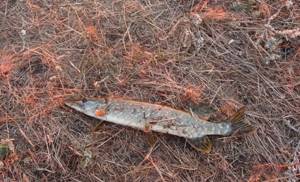
The object of the hunt this month chooses deep places; it is advisable to fish on riverbed dumps, edges, ditches, and in snags. Regarding gear, you will need tools with which you can make ultra-long casts. Bites also occur at the beginning of the winter season. During the late autumn feeding period, the fish rushes to any bait, but when fishing, it strongly resists. It’s better to go hunting when the water warms up; after lunch, the pike bite subsides.
Pike in the fall show a genuine interest in all types of silicone baits, spinners, especially live bait, so for greater effectiveness you need different bait options in your arsenal. The gear must be adequate to withstand the serious resistance of a predator. Only a competent approach will increase the chances of catching the coveted trophy.
Pike in October
By mid-autumn, the predator begins to show increased activity. Anticipating the oncoming cold snap, pike begin to gain fat in October. In search of prey, the predator rushes throughout the reservoir. On the one hand, this simplifies fishing, and on the other, it complicates it. It is important to equip gear and select bait for fishing in different horizons. Pike fishing in October depends on the characteristics of the reservoir.
The task is simplified on small lakes and small rivers. To catch toothy fish, a spinning rod, a float-based live bait fishing rod and summer baits are used. More often fishing is done from the shore, but using a boat always increases the chances of a good catch. In small rivers and flowing bays, pike in October can ambush in shallow water with a depth of 0.5 m.
On large rivers and other large bodies of water, fishing for pike in October is more difficult, but in such conditions the likelihood of catching a trophy individual increases. Fishing is carried out over a wide area using long-range spinning rods, circles and trolling. For fishing in clear water, baits with a length of at least 10 cm should be used.
What to use to catch pike in the fall
Predator hunting with a spinning rod in the fall is highly productive due to the ability to use a wide variety of baits, and of quite large sizes. But here you should know that starting from the second half of September, the use of surface baits is ineffective; options that are able to work in the middle and bottom water horizons are in demand. This category includes mainly silicone fish, many types of wobblers, and lures for pike fishing. For fishing to be successful, you will need a detailed familiarization with each of the varieties.
Spoon
This is the most catchy bait for the spotted beast in the autumn season. It is effective to use in windows free of vegetation. You can use both rotating and oscillating spoons. Rotators show their effectiveness in areas with a depth of up to 3 m, and oscillators - in deeper places.
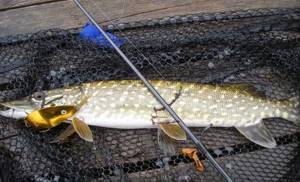
For information! It is better to catch pike with a spinner when fishing evenly, alternating a slow retrieve with a relatively fast one.
The spinners already have their own game settings from the manufacturer; no animation is required here. It is considered a classic device for attracting the attention of a predator.
Silicone baits
Among the fishing lures for pike, the following are especially popular:
- vibrotails, which have a hoof-shaped tail;
- products in the form of a twister, the tail of which is made in the shape of a sickle;
- baits in the form of worms, characterized by a long body;
- leeches, sausages, cuttlefish and other silicone options.
When choosing a bait for a toothy predator, it is better to give preference to versions with a massive and wide tail, which, when retrieved slowly, creates the impression of a live fish. As for color, you will need models in white, black, green and yellow. If fishing occurs at depth, it is recommended to use light blue silicone baits.
Wobblers and poppers
For catching pike, the most advantageous artificial baits will be products such as minnow, crank, fat and shad, which have a working blade. Also in the fishing box you need jerkbaits, rattlins, which, through their attractive game, cause wave vibrations and noise, which almost instantly draws the attention of the predator and attracts it to the fishing point.
For information! To hunt large specimens, jerkbaits and fat-type lures are chosen.
Often, when working with wobblers, skills are required, but cranks that have factory settings are easy to use and begin their game only when the required speed is available.
If you plan to hunt with poppers, then you should choose small baits measuring 6–10 cm. This option can lure pike of various sizes, and to catch trophy specimens you will need larger tools. If you need to fish a large location, then use sinking poppers, and for spot fishing - floating baits, which are distinguished by their ability to perform different animations.
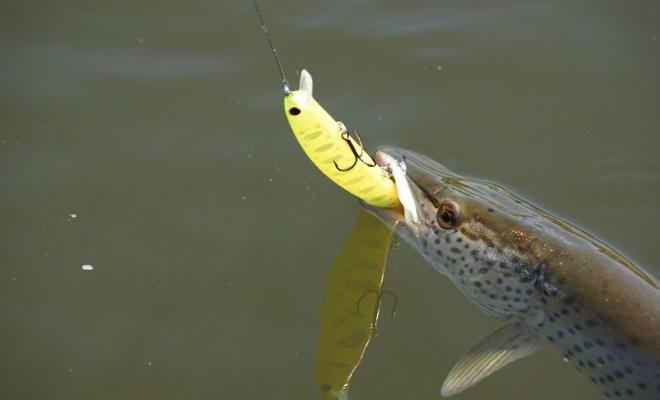
Zywiec
To attract a predator, they use live bait, which is found in a specific body of water. Purchased fish is not considered catchable bait . It is better to use gudgeon, ruffe, roach. And also perch, crucian carp, rudd. They also choose loach, silver bream, perch, and char. If we consider live bait that is capable of remaining in a mobile state for a long time, then ruffe and perch will occupy a leading position.
The size of the fish will depend on the size of the expected prey. To prevent perch from biting, the bait should be 7–12 cm long if the pike is small, and 12–18 cm if you are fishing for a large predator. It is good to use crucian carp weighing 300–400 g or more for a trophy.
Pike in November
After the first frosts and obvious cold snap, pike continue to feed in November. It does not fall into suspended animation and is successfully caught throughout the entire freeze-up period. But the intensity of the bite gradually decreases.
Most peaceful fish go deeper, approaching their wintering grounds. They are invariably followed by pike, but it moves less around the reservoir, rises to the surface extremely rarely, and again begins to hunt from ambush. Fishing for pike in November requires searching for promising places. Coastal depressions near lush reeds and the presence of bottom obstacles are good indicators of the possible presence of pike. In November, the predator can be found in shallow bays, into which small perch or roach often swim. These fish do not hibernate in winter, and often form the basis of pike’s diet during the cold season.
Spinning rod equipment for pike
To perform casts to the required distance and perform different types of retrieves, the equipment of a spinning rod for pike plays an important role. Of course, you can convert a Bolognese fishing rod of a suitable length (2.4-2.7 m) for spinning fishing, and perform wiring using any model of reel. But the discomfort will become obvious during the first hour of fishing: rapid hand fatigue, the inability to cast the bait far, etc. Although for fishing by trolling or floating the bait downstream, this assembly option can be used without any problems.
When equipping a spinning rod for targeted pike fishing, a number of nuances should be taken into account.
Light and medium spinning rods with a weight ranging from 5 to 25 grams are suitable for pike fishing. The test must correspond to the weight of the baits available in the arsenal. Build fast or super fast. Rigidity promotes timely and sharp hooking. It is unlikely that you will be able to break the jaw of an autumn pike confidently grabbing the bait. The length of the rod is selected according to the fishing conditions. It is convenient to fish from a boat or on a small river with a spinning rod 2.4 m long or less. It is easier to make long casts with 3-meter models. When actively fishing, the weight of the rod is selected according to the principle: the lighter, the better. If you plan to fish by trolling, then weight does not play a special role.
It is convenient to catch active pike in the fall with a high-quality spinning reel. It is convenient when delivering bait to the intended place, and simplifies the landing of resisting fish. Although there are many experienced spinning anglers who continue to hunt for pike with an inertial reel.
A spinning cord is used that can withstand a breaking load of 7 kg or more. A trophy pike with more weight can be hooked, but this is very rare. You can use high-quality fishing line with the same load capacity.
A metal leash is attached using a swivel, which acts as an anti-twist. All leashes of this type are equipped with carabiners, allowing you to quickly replace the bait during the fishing process.
Spinning lures for pike
In autumn, as well as the entire period of open water, spinning lures for pike are successfully used. This is a conditional phrase, but from the many artificial baits we can single out those that pike bite on more readily.
It should be noted that advertising tricks pointing to a specific “most catchy” pike bait manufactured by a well-known company are now common. But you shouldn’t persistently look for a wobbler or spinner with a certain marking. Moreover, prices sometimes bite. After all, no one is insured that after the first cast there will be a “deaf” hook, and the bait will be lost forever. Pike can also bite on homemade baits. The main thing is to give her a “game” that will attract the attention of the predator.
How to choose lures for pike
Large models with a length of 5 cm or more are used to catch pike. The predator pays little attention to the size of the bait. It is more important to choose a bait with appropriate buoyancy: for fishing above the bottom surface at great depths, in mid-water or in the upper horizon.
The following baits are suitable for pike fishing:
- Wobblers. Models with a noise effect attract predators well;
- Oscillating spoons;
- Rotating spoons with a petal length of about 5 cm;
- Twisters and vibrotails;
- Silicone analogues of small fish;
- Foam fish.
In cloudy weather, baits with bright and shiny colors are used, and on sunny days, preference should be given to baits with dark shades.
Technique for catching autumn pike using a spinning rod
Before the onset of noticeable autumn cooling, it is better to use a boat. By boat you can fish in areas that are inaccessible from the shore. This is not necessarily a distance from the coast, but rather a coastline with lushly growing reeds or reeds. It is in such places that pike hunt for small fish. In large bodies of water, trolling becomes possible. In order not to “catch” snags, you need to scout the bottom using a fishing echo sounder. The bait is placed along bottom obstacles. An active pike is able to catch up with the “escaping” bait.
How to catch pike in autumn
To ensure that autumn pike fishing is always successful, you need to have the right equipment. Depending on whether the hunt is carried out from the shore or from a boat, equipment, bait, and tackle are selected. All elements must correspond to specific fishing conditions.

For autumn pike fishing, if it is done from a boat, you will need:
- A rod up to 2.2 m long is generally sufficient for a 2 m spinning rod with a test load of 8–25 g. You should choose a stick with a fast or parabolic action.
- As the main thread, you should use a braid with a cross-section of 0.15-0.2 mm.
- It is mandatory that pike fishing tackle be equipped with a metal leash; the predator easily snacks on all other options.
- Spinning reel (2500–3000). If you are hunting for small specimens in calm, clear water, then a light spinning rod equipped with a 1500–2000 reel is quite suitable.
For information! When a spotted beast is hooked, it makes a candle during the fishing process, which does not happen when catching other aquatic inhabitants. This technique allows her to free herself from the steel sting that has dug into her.
When catching a toothy beast in the first month of autumn from the coastal zone, you will have to prepare serious gear. The rod is 2.7 m long with a test load of 35–40 mm when using large baits. To retrieve baits of lighter weight and with a higher degree of windage, it is better to choose a tool with a lower test load. But at the same time, the action should be medium or fast, which will allow you to cast over longer distances.
In addition, whenever hunting is carried out during the pike feeding period, you need to have a landing net, an extractor, a flashlight, and a yawner. The extractor and yawner are especially relevant when catching trophy specimens. Not a single evening hunt is complete without using a flashlight, especially when it gets dark early - October, November.
Equipment of a float rod for pike
Fans of stationary pike fishing in the fall successfully use a live bait float rod. The equipment of a float rod for pike has its own characteristics.
A rod with a length of 4-6 m is selected. With a shorter rod, the area for delivering live bait is limited. It is advisable to use a rod with a reel seat. You can fish without a reel, but this design is fraught with frequent derailments. If, when capturing live bait, the predator did not immediately swallow the hook into its mouth, then, feeling the resistance of the rigid equipment, it will most likely refuse the “prey”.
Any type of reel is suitable for a live bait float rod. You can use a simple inertial model equipped with a lock.
The fishing line must withstand a tensile load of 7 kg.
A float is used with buoyancy that can withstand live bait and the weight of the sinker used. The float can be made from dense foam:
- Cut a circle with a diameter of 4.0-4.5 cm and a thickness of 2.0-2.5 cm;
- Drill a hole in the center of the circle in which to secure the cambrig using glue;
- Cover the upper part with water-repellent paint, the color of which is clearly visible on the surface of the water.
A stopper is installed above the float. It is better if it moves under slight force. A nipple or cambrig, which is secured with a match, is suitable for its manufacture.
A 6-8 g sinker is tied below the float. Below the sinker you need to leave a piece of fishing line. After tying the leash, the total length to the sinker should be 20-40 cm to ensure free movement of the live bait.
A tee or double is attached to a metal leash using a winding ring. The leash is attached to the main line using a swivel.
Technique for catching pike with a float rod
Live bait can be prepared in advance or caught after arriving at the reservoir. Small perch or crucian carp are excellent bait for pike. You can attach live bait in any convenient way.
Live bait is cast, and its behavior is controlled by the displacement of the float. When the fish approaches existing thickets, you should recast.
When the bite starts, you don’t need to hook right away. Premature hooking can pull the bait out of the pike's mouth. You need to wait a few seconds for the predator to securely capture the fish. If the line tension is strong, it is better to release a few meters. Then place the reel on the stopper and hook.
When playing, you shouldn’t fuss and force events. The more fatigued the pike is, the easier it is to remove it to the shore or into the boat.
Pike autumn wobblers
I’ll start with wobblers themselves, as the most popular bait when fishing for pike with a spinning rod, and no less effective in the fall than other types of bait. This topic is very large, so I will try to break wobblers into several groups and highlight the best representatives among them.
Large minnow wobblers 130 mm+
This is a fairly popular class of wobblers among our spinners, which is simply called “large wobblers.” If suddenly this aphorism slips through the forum, then it is understood as a minnow 130+.
These wobblers have several undoubted advantages:
- they are voluminous, large and are desirable prey for autumn pike, which eats off before winter;
— they emit good vibration, many of them also make noise, due to which they attract pike from afar;
— they are often equipped with three treble hooks, which provide a high percentage of bites;
— they are heavier than their smaller counterparts and fly further when casting;
- pike extremely rarely swallow them whole, they are often caught from above the mouth and are much easier to free.
The most prominent representatives of this group are:
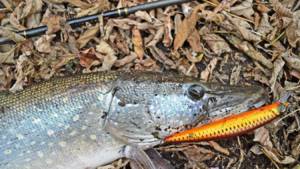
OSP Asura Rudra Jerkbait 130SP , as well as its more budget analogues, for example, Kosadaka Flash 130SP, Strike Pro Montero 130SP and Tsuoki Chance 130SP. There are others, but these 4 models in my conditions are the most popular in the fall when fishing for pike. It was not by chance that he pointed out neutral buoyancy; in autumn, especially late, pike often like long pauses, so baits hanging in the water column often help out. All of them have a beautiful and individual game in their own way, retain residual fluctuations during pauses, prefer twitching wiring, on which they consistently scour the sides. Working horizon from 1 to 2 meters.
Jackall Mag Squad 128SP. He also has copies, although there are fewer of them, but they cannot compare with the original. This wobbler has the clearest “herringbone” pattern among the 130s; it starts easily and is always stable in the wiring. Also a suspender, it hangs perfectly after stopping and sways its sides beautifully. There is a noise capsule inside, which additionally attracts pike. The main wiring horizon is from 1 to 1.5 meters.
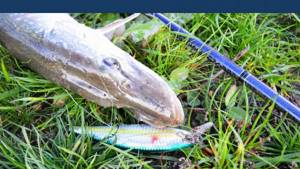
Renegade Riddle 128SP . This is a copy of the well-known Lucky Craft Pointer 128SP, but it, unlike its much more budget-friendly brother, did not work for me. First of all, because it required a stiffer spinning rod and powerful wiring. Riddle starts up much easier, otherwise repeating its famous colleague: beautiful turns and swaying sides will not leave the pike indifferent!

Megabass Kanata . The wobbler is size 130+++ and it is in this section for a reason. The 16-centimeter minnow from Megabass is a perfect “large wobbler”, Megabass Kanata has an excellent game both on a uniform and twitching retrieve. This lure is hard for pike not to notice or hear! Also prominent representatives of the series are Deps Balisong 130SP, Megabass Oneten Magnum 130SP and others.
The best rolling wobblers
Rolling in the wobbler theme is associated with the vibrations of these baits in the water. There are several types of them, but we will not dwell on each separately, because we are only interested in one. Rolling is the oscillation of a wobbler around its longitudinal horizontal axis. Most often, this word is used to describe the behavior of a wobbler after stopping - if it sways on its sides, then the foreign word will be appropriate. So, the more of these fluctuations and the more distinct and longer they remain paused, the better for the pike. Not always, but in the fall such fluctuations are very appropriate, especially when the pike is passive and we take long pauses. Regardless of the size of the wobbler, this behavior has a positive effect on autumn pike fishing.
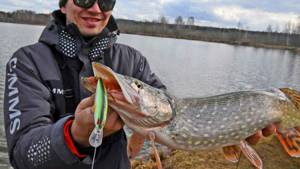
The best “rolling” wobblers, in my opinion, are:
Nories Laydown Minnow 110SP is one of the best in pause behavior. It turns on the spot and, after stopping, performs a whole series of damped oscillations. Pike are simply crazy about this bait! It works great at a depth of up to one and a half meters, collecting all living things. Pontoon 21 Greedy Guts is not just one wobbler, but a whole series from 44 to 111 mm long with a lot of buoyancy, but in the fall, suspenders ranging from 77 mm in length and larger are also the most effective.
Unlike many twitching wobblers, Greedy Guts prefers softer spinning rods and does not require jerking with the recoil of the cord. But during pauses he does something incredible! No worse is his “show-off” colleague Crackjack, which in all sizes, no less, makes even the most passive predator fly out of cover and pick their teeth. Deps Balisong will also not leave autumn pikes indifferent to its bright fluctuations during the pause. This bait allows you to make very long retrieves with pauses of up to several tens of seconds. You could already drink a glass of tea during this time, you’re standing there with a spinning rod in your hands, and suddenly “bam”! Balisongs are also very noisy, so they are great at raising pike from great depths.
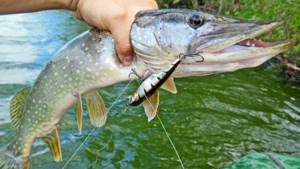
We can’t help but mention the outstanding representatives of the Tsuribito brand – Jerkbait and Minnow. The first ones belong to the “shad” class and are floating in the factory version. Even in this version, they have a very active game and bright vibrations, but if you load them to neutral buoyancy, then they will give many a head start both in “rolling” endeavors and in autumn pike fishing. In this rating, wobblers are among the best! He will have few competitors when it comes to luring pike out of snags.
Their fellow model Minnow in pike size 130 also comes in a floating version, but in cold autumn water with a metal leash it practically hangs in place, and if you glue a little lead on it, it will become an ideal suspender. It catches pike in shallower areas, but also attracts catfish very well. It also makes noise, which sometimes additionally unbalances the pike.
Of course, almost every well-known manufacturer has such wobblers. For example, Lucky Craft’s entire Pointer series has great rolling and catches great pike in the fall. Megabass boasts its legendary Vision, which in neutral buoyancy gives heat to autumn pike. Zip Baits has a whole galaxy of wobblers with a pronounced rolling action that will not allow pike to pass at any time of the year. These are the Rigge, Orbit and of course Khamsin series.
There's a reason they have so many copies. It is impossible not to mention the rare, but very catchy wobbler from Imakatsu - Riprizer. Its “rolling” can easily be considered a standard one, which is why it is encountered with pike on a regular basis. Among the more inexpensive ones, there are also plenty of really cool wobblers with the described property. Strike Pro has successful series Bold, Jumper, Inquisitor, and so does almost every brand! Kosadaka is represented by many such wobblers, such as Mirage, Mystic, Flash, etc.
Composite wobblers
We are talking about wobblers that have 2 or more components, mainly neutral buoyancy and twitching orientation. In the fall, in my practice, compound wobblers come to the rescue much more often than at other times of the year. Largely due to his impressive game. Some of the best fall compound wobblers include the Jackall Magallon and its little brother labeled Tiny. Tini somehow didn’t take root with me, but the 105th, on the contrary, worried the minds of all local pikes for a long time. Jackall Magallon is endowed with its own active game, but is most effective on a slow retrieve with long pauses of both a jerking nature and stop & go. This is a simple and understandable wobbler, with which it is very difficult not to catch an autumn pike. Even at the moment after cutting the last Magallon, I decided not to buy it and fish with more budget analogues.

And I can say that the Strike Pro Glider in both versions and the Kosadaka Cord-R performed no worse than the original and caught a considerable number of pike. The Savage Gear 4Play Herring Liplure is another trouble-free unit from the regiment of compound wobblers. It comes in many sizes, many of which are close to jerk, so they often produce the most interesting results in the fall. The 4Play itself is slow-sinking, which allows you to conduct wiring in different horizons. Unlike most two-part wobblers, the snake from Savage Gear has 4 parts at once, which, when jerked, produce something unimaginable! Single short jerks turn the wobbler in place, pirouettes are still the same! For autumn passive pike, he is one of the best. Jackall Giron and his Baby version, as well as their various lines. For example, I like Renegade...

We can’t help but mention the rarer “beast” Gan Craft Jointed Claw - one of the most unpredictable compound wobblers that creates something absolutely incredible in the water, sometimes even the pike doesn’t know what to do with it. And almost always the pike attacks him! An unimaginable wobbler, the only big disadvantage of which is its price. There are far fewer of these types of wobblers, but almost every brand has a few.
Pike cranks

It is in the fall that cranks come to the rescue most often compared to other times of the year. For two seasons they were generally the best autumn wobblers for me. Among them there are both classic models that work on uniform wiring, and jerky ones that lend themselves well to animation. The most striking impression on me was made by the crank from Liberty and subsequently Itumo called Samba 100F, although its predecessor also had models of the SP version. This is a 6-centimeter pike crank with active play and a depth of up to 1 meter. But its main advantage is its excellent game on twitching wiring. The crank is also noisy, during jerks you can hear it from afar, it turns perfectly on the spot, staying in the field of view of the pike for a long time. This is undoubtedly the best jerk crank for pike fishing and it is just perfect for autumn!
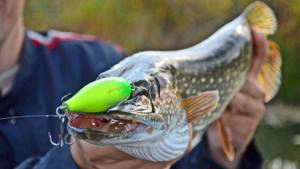
Of course, he also has competitors among jerks. For example, the Strike Pro Cranky X-50 and Megabass Griffon 6CC are excellent at catching autumn pike. They also play beautifully on jerks, imposingly waddle from side to side and famously provoke autumn pikes to attack. Lucky Craft also has many interesting cranks for pike fishing - the famous Clutch series and the lesser known LC series. They also work both at regular intervals and in jerks. Good pike wobblers! But the best among the equals is the rare beast Tsunekichi Nanko Crank 59SR. I have never seen anyone play more extensively among the cranks, which is why the pikes can’t let it pass by.
Other live bait gear for pike
Summer girders and mugs are suitable for catching pike with live bait in open water. The principle of equipping these tackles is the same: a sinker to hold live bait above the bottom surface, a metal leash and a hook. They differ only in the base, which plays the role of a coil.
Summer girders are used for fishing from the shore, and pike fishing with mugs is carried out at a distance from the coastline using a boat.
Pike fishing in the fall is an exciting activity. Outwitting a predator is not easy. But the efforts made are usually crowned with success. Fighting with big fish always brings a lot of positive and unforgettable impressions.

